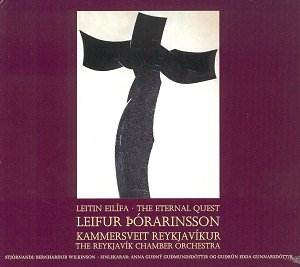Iceland’s leading composer Leifur Thórarinsson
first studied violin at the Reykjavik School of Music and went
on to play with the Iceland Symphony Orchestra. In the 1960s,
he studied composition under Wallingford Riegger and Gunther Schuller.
A prolific composer, he wrote music for all media, including opera
and more than sixty pieces for theatre productions. Schuller himself
said of his erstwhile pupil, ‘Leifur has been the leading
composer in Iceland for the last thirty years. If not for the
recent quantity of releases featuring Icelandic composers and
musicians, most people would assume there wasn’t significant music
from there. I am particularly proud to contribute to this belated
recognition’.
This disc provides both an intriguing panorama
of the variety in styles and forms Thórarinsson favoured,
and is an excellent introduction to his thoroughly approachable
music. He clearly had uncompromising integrity as a composer,
as he himself said ‘one always describes some kind of experience
in one’s work. It is impossible to lie in music’. Although a convinced
exponent of Second Viennese School serialism, in the end he found
a personal style which took and incorporated elements not only
from Schoenberg but also Stravinsky and jazz. Rent explores
a large array of string sounds (it was commissioned by the Swedish
Chamber Orchestra for a sum which paid a month’s rent) in short
motivic fragments, dissonant note clusters and wide-ranging glissandi,
all constantly seeking resolution seemingly without ever achieving
it. Not even a deformed classical minuet played by a concertante
string quartet can solve the dilemma until a four-part hymn quietly
appears and resolves the confusion by an assertion of faith in
God. Further religious influences can be found in Angelus Domini
in a translation from a medieval Latin poem, a simple, unambiguous
work which effectively conveys the serenity of the poem’s mood.
Three of four chamber concertos he completed
before his death appear here on tracks 1, 3 and 6, the Notturno
capriccioso entitled Styr (meaning ‘disagreement’ or
‘battle’) using the same orchestration as Schoenberg’s first chamber
symphony which was part of the programme at the work’s 1988 premiere
at the Reykjavik Arts Festival. The battle of ideas or between
people is represented in musical terms by the somewhat unequal
struggle between piano and chamber orchestra, with a hint of an
allusion to the Dies Irae once again introducing a religious
element, but at the end it is quite unclear if in fact there have
been either winners or losers. In Cyprus pretty well reflects
its title, Byzantine church frescoes and icons inspiring its composition
during the year he lived there. A longer sojourn in Denmark produced
the lovely work for harp and strings A Dream of the ‘House’
a brief intermezzo entitled Interlude-Pantomime. Spring
in my Heart is vivacious and bustling with energy with plenty
of opportunity for its dozen soloists to display their abilities,
including an elaborate cadenza for flute, marimba, vibraphone
and guitar.
His death five years ago was untimely, for he
was at the peak of his creative powers and had a universal message
in his music. Clearly all the performers here have received and
understood his musical message and have had a significant working
relationship with Leifur Thórarinsson, whose music now
deserves a wider hearing. It is music well worth the effort of
getting to know.
Christopher Fifield
